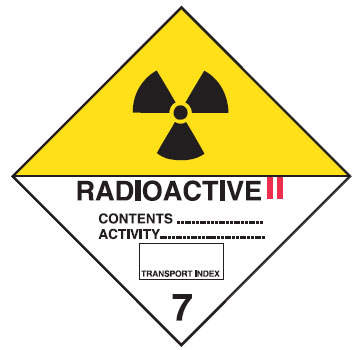Have you ever seen a container truck on the road with this symbol?

Every year, millions of radioactive materials are transported worldwide — radiopharmaceuticals, radioisotopes for agriculture and radioactive substances for nuclear fuel production.
If you’ve seen radioactive signage on a vehicle, then you’re right to keep a safe distance. Although there are no severe accidents recorded in transporting radioactive substances, it’s always best to be safe.
Regulations for Safe Transport
Radioactive materials can be transported by truck, train, plane or ship.
Each country has its own regulations on transporting radioactive materials. In Australia, ARPANSA implements the Code for the Safe Transport of Radioactive Material (2019) (Radiation Protection Series C-2, Rev. 1) (Transport Code). This Code adopts the International Atomic Energy Agency (IAEA) Specific Safety Requirements.
For companies or organisations seeking approval to transport radioactive material, ARPANSA also provides a Regulatory Guide for Transport of Radioactive Material to meet the requirements of the Code.

As a general provision, there should be an established radiation protection programme for transport. To assess the effective dose from transport activities, there should be workplace monitoring and if it’s likely to exceed 6 mSv in a year, individual monitoring is conducted.
Persons involved in the transport of radioactive materials should receive training, including precautions to limit their exposure as well as the exposure of people outside work. They should know the proper handling and stowage of the packages.
Proper Packaging of Radioactive Materials
Security and controls are set depending on the amount and type of radioactivity. Each person involved in handling radioactive materials for transport should receive training on classifying, packing, marking and labeling, and segregating.
Based on the IAEA regulations, there are four types of packaging:
- Excepted packages are usually small amounts like test samples and some medical isotopes. They just need to meet the most basic packaging requirements.

- Type A packaging is usually for intermediate quantities of radiopharmaceuticals and some industrial products. These are subjected to tests like water spray for rainfall simulation, drop test and compression.

- Type B packaging is for large quantities and should be able to withstand accidents. Spent nuclear fuel is one high-level radioactive material that is transported in Type B packaging. They are shipped in specially designed containers called casks. These undergo extreme tests like burning or dropping to ensure they can contain the material in case of accidents.

- Type C packages are for air transport of larger quantities.

Radioactive packages are classified as dangerous goods and must carry the Dangerous Goods 7 stickers with the nuclear trefoil attached.
Protect Yourself In Case of Accidents
- Stay as far as possible and do not touch any cargo.
- Report any accident.
- Contact a doctor if exposed.
Real-Time Radiation Monitoring
Simplify and improve your operations with SensaWeb’s radiation monitoring services. Our monitors send radiation and location data in real-time, every TWO seconds, using multiple communication methods. Multiple units can be installed in fixed positions or in vehicles, which allows organisations to keep track of radiation levels in remote facilities. Authorised staff can then view this data on the report generation and management platform, anywhere and on any device.
The user can set whatever limits they wish on the monitor; any breach of those limits will trigger an email and text message alert to the official responsible for radiation health and safety.
Connect with us here https://www.sensaweb.com.au/contact/ or our email address: info@sensaweb.com.au. You can also call us at +61 415 409 467.